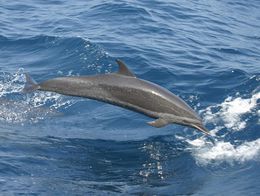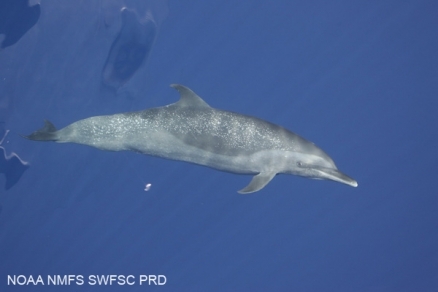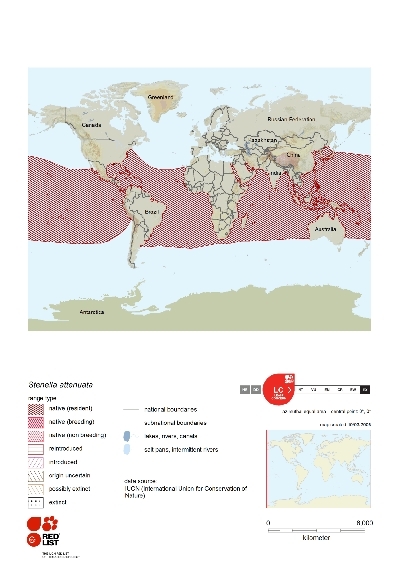Pantropical spotted dolphin
The Pantropical spotted dolphin (Scientific name: Stenella attenuata) is a marine mammal within the family of oceanic dolphins, part of the order of cetaceans, that is found in all the world's oceans between about 40°N and 40°S. The gregarious pantropical spotted dolphin forms schools that can range in size from less than one hundred to thousands of individuals.
The pantropical spotted dolphin is well known for its tendency to associate with schools of tuna in this region. While this may be due to an overlap in diet, other reasons for this association have also been suggested, such as increased protection from predators, as there is safety in numbers. As a result of this association, Pantropical spotted dolphin have been frequently killed as a bycatch in the fishing of yellowfin tuna with purse-seine nets.
The pantropical spotted dolphin is a fast swimmer that often engages in a range of aerial acrobatics and will frequently ride the bow waves of boats, except in tuna fishing grounds where it has learnedto avoid vessels. Juveniles in particular are known to make astoundingly high vertical leaps out of the water.
 Juvenile pantropical spotted dolphin (Stenella attenuata) in the eastern tropical Pacific. Source: Robert L. Pitman, NOAA Fisheries Juvenile pantropical spotted dolphin (Stenella attenuata) in the eastern tropical Pacific. Source: Robert L. Pitman, NOAA Fisheries
|
 Size comparison of an average human and a pantropical spotted dolphin (Stenella attenuata). Source: Chris Huh Size comparison of an average human and a pantropical spotted dolphin (Stenella attenuata). Source: Chris Huh
|
| Conservation Status Least Concern |
|
Scientific Classification Kingdom: Animalia (Animals) |
|
Common Names Bridled dolphin |
Contents
Physical description
The pantropicalspotted dolphin received its namebecause its skin becomes spotted as the dolphin grows older. Its dorsal surface is dark gray but covered in paler spots, while its paler ventral surface is covered with dark spots. Another distinguishing feature is the spotted dolphin's bright, white snout. It also has melon, a fatty area located on its forehead. The inshore spotted dolphins tend to be larger in size than offshore dolphins. Males also typically have larger body sizes than females, yet females have longer rostra. The spotted dolphin has between 29 and 37 small, rounded teeth on either side of its upper and lower jaws. It has pectoral fins (on the sides), a dorsal fin (on the central back), and tail flukes. The blowhole, used for breathing and communication, is located on the top of the head. BecauseStenella attenuate has a thin layer of blubber, it has small amounts of stored energy, so it consumes high energy foods to compensate for the low energy storage.
Reproduction
The mean age of sexual maturity for northern offshore female spotted dolphins is estimated to be 11.1 years, which is higher than the estimated age of 9.8 years for southern offshore females. On the other hand, males' average age of sexual maturity is 14.7 years. S. attenuata does not have any particular birthing season, although the number of births does rise in spring and autumn months. The time between births is between 26 and 36 months in the eastern Pacific and approximately 48 months near Japan. The gestation period lasts a little less than a year, and the lactation period can last for 1.5 years or longer. Females usually give birth to a single offspring.
This lactation period is more than three times as long as other large whales. Occasionally females have been known to lactate during a new pregnancy, and some have also been known to give birth to twins, although this is rare. Mother dolphins feed near the surface so that they do not need to leave their calves. Pregnant females up to 35 years in age have been found.
While the breeding system of this species is not known in detail, it is possible that it may be promiscuous, like that of the closely related Spinner dolphin (Stenella longirostris).
Lifespan
The maximum longevityof the pantropical spotted dolphin is 46 years in thewild.There are reports of pregnant females up to the age of 35. Their maximum longevity could be underestimated.
Behavior
This spotted dolphin is a gregarious animal, swimming in pods of several to several thousand dolphins. The offshore schools tend to be larger in number than those of the inshore dolphins. At the age of two years, young Japanese Stenella attenuata join pods of other young animals until they achieve sexual maturity. At that time they return to their original pod. Japanese Stenella attenuata females also have been known to leave their pods during estrous. Age and gender separation do not appear to take place within the tropical Pacific schools.
It is an extremely fast animal, capable of swimming between 22 and 28 km/hr. It is an acrobatic species as well, possessing the ability to leap to great heights.Spotted dolphinsuse echolocation to locate its prey and to communicate with other spotted dolphins.
Distribution
Stenella attenuatalives in the Atlantic, Indian, and Ocean Pacific oceans (all oceans, between about 40°N and 40°S ). It migrates seasonally to the Japanese coast and is the most common cetacean in the Gulf of Mexico. The pantropical spotted dolphin lives in some enclosed seas, like the Red Sea and Persian Gulf, but notall (e.g. the Mediterranean Sea).
Habitat
Stenella attenuata lives in the tropical and subtropical areas of the ocean and seas. Although some live inshore, most members of the species live offshore, where the temperature of the deeper water remains fairly constant. The majority of this species live in between the equator and the Galapagos Islands for the same reason that they tend to live offshore. The home range is hundreds of kilometers in diameter.
Ecosystem roles
This dolphin is prey for the Killer whale (Orcinus orca)and a number of sharks.
Food habits
This spotted dolphin finds its prey, squid and small fish, near the ocean surface. These dolphins have also been known to feed on isopods and pteropods (free-swimming sea slugs). Lactating females eat significantly more fish than pregnant or normal spotted dolphins. The lactating female's deviation from the norm is presumably because she requires more energy than normal and pregnant dolphins. More protein and also more energy is obtained from eating fish, rather than from eating the same mass of squid. In addition, fish also contain more calcium and phosphorous, which aid in lactation. Lastly, fish have lower water content, which prevents additional water loss in the lactating female since the consumed fish are hypotonic with the sea water.
Conservation status
Classified as Least Concern (LC) on the IUCN Red List and listed on Appendix II of CITES.
Threats
Because Stenella attenuata tend to swim with yellowfin tuna, Pacific fishermen use sightings of these dolphins to help them locate their yellowfin tuna targets. The majority of Stenella attenuata deaths are a consequence of yellowfin tuna fishing operations. The enormous nets used to catch these tuna can unintentionally entangle dolphins as well as fish. Stenella attenuata is the dolphin species that has been affected to the greatest extent by the tuna fish industry. Between 1985 and 1990, almost 130,000 were killed each year because of the tuna fish catching methods. Thanks to United States government regulations, such as requiring improvements in fishing equipment, this number has decreased substantially by 100,000 deaths per year. Some spotted dolphins are killed intentionally by Japanese fishermen. Between 500 and 2000 spotted dolphins are harvested annually in order to be eaten by the Japanese.
References
- Encyclopedia of Life
- IUCN Red List
- Perrin, W. (2008) Pantropical spotted dolphin. In: Perrin, W.F., Würsig, B. and Thewissen, J.G.M. Eds. Encyclopedia of Marine Mammals. Second Edition. Academic Press, London.
- Jefferson, T.A., Leatherwood, S. and Webber, M.A. (1993) FAO Species Identification Guide. Marine Mammals of the World. FAO, Rome.
- Reeves, R.R., Smith, B.D., Crespo, E.A. and Notarbartolo di Sciara, G. (2003) Dolphins, Whales and Porpoises: 2002–2010 Conservation Action Plan for the World's Cetaceans. IUCN/SSC Cetacean Specialist Group. IUCN, Gland, Switzerland and Cambridge, UK.
- Gerrodette, T. (2008) Tuna-dolphin issue. In: Perrin, W.F., Würsig, B. and Thewissen, J.G.M. Eds. Encyclopedia of Marine Mammals Second Edition. Academic Press, London.
- Banks, R. C., R. W. McDiarmid, A. L. Gardner, and W. C. Starnes. 2003. Checklist of Vertebrates of the United States, the U.S. Territories, and Canada
- Banks, R. C., R. W. McDiarmid, and A. L. Gardner. 1987. Checklist of Vertebrates of the United States, the U.S. Territories, and Canada. Resource Publication, no. 166. 79
- Bernard, H.J. and A.A. Hohn. (1989). Differences in Feeding Habits Between Pregnant and Lactating Spotted Dolphins (Stenella Attenuata). Journal of Mammology. 70(1): 211-15
- Chivers, S.J. and A.C. Myrick Jr. (1993). Comparison of Age at Sexual Maturity and other Reproductive Parameters for Two Stocks of Spotted Dolphin, Stenella Attenuata. Fishery Bulletin. 91: 611-18
- Edwards, E.F. Allometry of Energetics Parameters in Spotted Dolphin (Stenella attenuata) from the Eastern Tropical Pacific Ocean. Fishery Bulletin. 91: 428-39
- Felder, D.L. and D.K. Camp (eds.), Gulf of Mexico–Origins, Waters, and Biota. Biodiversity. Texas A&M Press, College Station, Texas.
- Gordon, D. (Ed.) (2009). New Zealand Inventory of Biodiversity. Volume One: Kingdom Animalia. 584 pp
- Gray, J. E., 1846. On the cetaceous animals. Pp. 13-53, in The zoology of the voyage of H.M.S. Erebus and Terror, under the command of Capt. Sir J. C. Ross, R. N., F. R. S., during the years 1839 to 1843 (Sir J. Richardson and J. E. Gray, eds.) [1844-1875], 1:44. E. W. Janson, London, 2 vols.
- UCN (2008) Cetacean update of the 2008 IUCN Red List of Threatened Species.
- International Commission on Zoological Nomenclature. 1991. Opinion 1660: Steno attenuatus Gray, 1846 (currently Stenella attenuata; Mammalia, Cetacea): specific name conserved. Bulletin of Zoological Nomenclature, vol. 48, part 3. 277-278
- Jefferson, T.A., S. Leatherwood and M.A. Webber. 1993. Marine mammals of the world. FAO Species Identification Guide. Rome. 312 p.
- Lang, B. Pan-Tropical Spotted Dolphins, Stenella Attenuata. Minerals Management Service Gulf of Mexico OCS Region.
- Longevity Records: Life Spans of Mammals, Birds, Amphibians, Reptiles, and Fish (Online source)
- Mead, James G., and Robert L. Brownell, Jr. / Wilson, Don E., and DeeAnn M. Reeder, eds. 2005. Order Cetacea. Mammal Species of the World: A Taxonomic and Geographic Reference, 3rd ed., vol. 1. 723-743
- Myers, P. 1997.Animal Diversity Web.
- North-West Atlantic Ocean species (NWARMS)
- Nowak, R.M. 1997. Walker's Mammals of the World online version.
- Perrin, W. (2010). Stenella attenuata (Gray, 1846). In: Perrin, W.F. World Cetacea Database. Accessed through: Perrin, W.F. World Cetacea Database (accessed 2011-02-05)
- Perrin, W. F., E. D. Mitchell, J. G. Mead, D. K. Caldwell, M. C. Caldwell, P. J. H. van Bree, et al. 1987. Revision of the spotted dolphins, Stenella spp. Marine Mammal Science, vol. 3, no. 2. 99-170
- Perrin, W.F., and G.D. Schnell, D.J. Hough, J.W. Gilpatrick Jr., J.V. Kashiwada. (1994). Reexamination of Geographic Variation in Cranial Morphology of the Pantropical Spotted Dolphin, Stenella Attenuata, in the Eastern Pacific. Fishery Bulletin. 92: 324-46
- Perrin, William F. 1990. Case 2717: Steno attenuatus Gray, 1846 (currently Stenella attenuata; Mammalia, Cetacea): proposed conservation of the specific name. Bulletin of Zoological Nomenclature, vol. 47, part 1. 32-37
- Perrin, William F. 2001. Stenella attenuata. Mammalian Species, no. 683. 1-8
- Rice, Dale W. 1998. Marine Mammals of the World: Systematics and Distribution. Special Publications of the Society for Marine Mammals, no. 4. ix + 231
- UNESCO-IOC Register of Marine Organisms
- Wilson, Don E., and DeeAnn M. Reeder, eds. 1993. Mammal Species of the World: A Taxonomic and Geographic Reference, 2nd ed., 3rd printing. xviii + 1207
- Wilson, Don E., and F. Russell Cole. 2000. Common Names of Mammals of the World. xiv + 204
- Wilson, Don E., and Sue Ruff, eds. 1999. The Smithsonian Book of North American Mammals. xxv + 750
- van der Land, J. (2001). Tetrapoda, in: Costello, M.J. et al. (Ed.) (2001). European register of marine species: a check-list of the marine species in Europe and a bibliography of guides to their identification. Collection Patrimoines Naturels, 50: pp. 375-376

